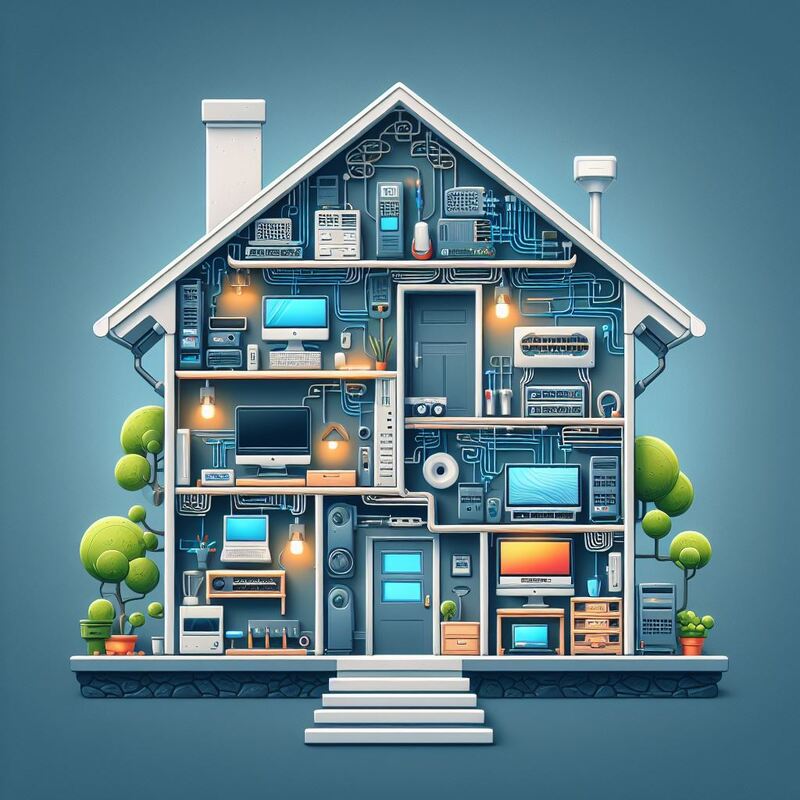So, you’ve got more tech in your house than NASA had in the ’60s, but you’re scratching your head thinking, “How on earth do I connect all this?” Fear not, tech-struggler, you’ve stumbled upon the proper tutorial. We’ll guide you through setting up a home networking system so striking your toaster will chat with your fridge in no time! From picking equipment that won’t have you pulling your hair out to ensuring your devices become inseparable besties, we’re here to save the day. If you’ve had enough of playing tug of war with network issues, we’ve got a lifeboat ready. Buckle up; it’s time to make your tech life smoother than a jazz radio station!
Understanding Home Networking Basics
Before you plunge headfirst into the deep end of the pool setting up your home network, it’s a good idea first to learn how to swim. And by swim, I mean understanding the essential ingredients in this network soup. Get friendly with different network types. You’ve got your wired networks, like Ethernet, like your reliable old aunt who always remembers your birthday. And then there are the wireless ones, such as Wi-Fi, the adventurous uncle who always brings you gifts from his travels. Each has strengths and quirks, and knowing these can help you pick your favorite relative.
Internet protocols are the unsung heroes of this networking saga. They’re like the traffic cops for data, ensuring everything moves smoothly and no one jumps a red light. For instance, you’ve probably heard of TCP/IP. It’s a suite of protocols that acts like the big boss of how data moves across networks. Without it, your devices would be like a bunch of kids on a sugar rush – all over the place. In short, understanding network types and Internet protocols gives you a sturdy base, much like the perfect crust for your home network pizza. So, pull up your socks because you’re now geared up for the next step in this networking adventure.

Choosing Your Networking Equipment
Now that you’ve aced Networking 101 let’s dive into the wild world of choosing the right networking equipment for your home. First up on the agenda: equipment compatibility. It’s like dating – you want to make sure the devices you’re planning to connect can get along without throwing a fit. You certainly want to avoid ending up with a router as compatible with your devices as oil is with water, do you?
Moving on to the serious stuff, well, as serious as it gets in the networking world – network security. Think of it like your home’s guardian angel. Choose equipment that has security features that are beefier than a bodyguard. Routers with built-in firewalls or other protective measures are always a good choice. Remember, your home network is only as secure as its weakest link, or in our case, the laziest device. So, invest in equipment that treats your data like a top-secret mission.

Setting Up Your Wireless Router
Setting Up Your Wireless Router (And Keeping Your Sanity)
So, you’ve finally decided on your dream networking equipment. Now it’s time to roll up your sleeves, put on your best tech support voice, and dive into the exciting world of wireless router setup! The first step is like marking your territory: you’ve got to change the router’s default username and password to something unique and strong. It’s your first line of defense against those pesky Wi-Fi thieves.
Now, let’s get physical. Time to connect your router to the modem with an Ethernet cable. It’s like they’re going on a date, and you’re the chaperone. Once they’re happily connected, plug in the router and wake up your computer.
Get ready to play hide-and-seek with your router’s interface. You’ll need to access it through your web browser. Its IP address is your only clue, and you can find it in the most thrilling page-turner known to humanity: the router manual.
When you thought you were done, there’s one more task. It’s time to check for router firmware updates. Manufacturers often release these to improve performance and security, like giving your router a secret superpower. Make sure you’re getting all the latest tricks your router can do.
And there you have it! You’ve successfully set up your wireless router, and you didn’t even break a sweat. Now, you can bask in the glory of your accomplishment and enjoy uninterrupted binge-watching sessions. Congratulations, you tech wizard, you!

Connecting Devices to Your Network
Having just won the epic battle with the mythical beast known as “wireless router setup,” you’re ready for your next quest: connecting your devices to your network. This thrilling adventure involves three key milestones:
- Identify your device: Check its compatibility with your router. Most devices these days are born with Wi-Fi abilities, but some older ones, like Grandpa’s first computer, might need a Wi-Fi adapter walking stick.
- Connect your device: Have your device play hide and seek with your network’s name (SSID) in its Wi-Fi settings, and when it finds it, whisper the secret password.
- Monitor your network: Be the ever-watchful guardian of your Network Bandwidth realm, ensuring internet-hungry devices do not trample it.
And let’s remember Device Security. It’s like garlic to vampires, keeping those pesky unauthorized accesses at bay. You’ll need a robust and unique password, the digital equivalent of a dragon slayer. With these steps, you’re well on your way to becoming the ruler of your fully functioning home network kingdom!

Troubleshooting Common Network Issues
Despite your best efforts and possibly crossing your fingers and toes, you may still encounter some pesky network issues. So, please put on your detective’s hat, get your magnifying glass, and let’s dive deep into the dark, mysterious world of troubleshooting. Remember, network error solutions are usually as simple as knowing your left from your right… or, in this case, your modem from your router.
Problem Diagnosis Solution No connection Is your network cable plugged in, or is it just hanging out, enjoying a cup of coffee? Give it a job. Reconnect it. Slow internet Do a speed test. Is your internet slower than a snail on holiday? Time for a router reboot. Like us, they need a nap too. Can't connect to a specific website Try accessing the site from another device. Is it just your device throwing a tantrum? If so, your device may need a time-out. Frequent disconnections Is your network overloaded, like a buffet plate at an all-you-can-eat? It's time to slim down. Disconnect the freeloaders. Can't print from network printer Is your printer online and connected, or is it on a lunch break? Reconnect your printer; it's probably done with its sandwich by now.
Frequently Asked Questions
Can I Set up a Home Networking System Without Any Prior Technical Knowledge?
You bet your Wi-Fi password you can! Who says you need a techy brain to set up a home networking system? Not us! With the right networking gadgets (that hopefully won’t start speaking alien language) and a few DIY tips that won’t make you pull your hair out, you’ll be surfing the web faster than a cat chasing a laser pointer!
How Much Will It Cost to Set up a Complete Home Networking System?
Well, let’s dive into the world of home networking systems, where the costs are as unpredictable as the weather! It’s like asking how much a vacation will cost – it depends on whether you’re pitching a tent in your backyard or jet-setting to a five-star resort in the Maldives! So, in the grand spirit of financial vagueness, expect to shell out somewhere between $100 to $200 for a basic setup. And remember, this isn’t a fancy Italian dinner – more expensive doesn’t always mean better!
Is Any Specific Maintenance Required Once the Home Networking System Is Set Up?
Specific maintenance is like the secret sauce to your network’s fountain of youth. Regular updates could be your new hobby, frequent checks for connectivity issues might become your pleasure, and troubleshooting tips can prevent potential problems faster than your dog gobbles up his dinner. It’s manageable if you’re a couch potato. But beware, neglecting it could lead to more significant issues, like explaining to your kids why their internet games suddenly froze.
Can a Home Networking System Lead to Increased Internet Speed?
A home networking system can give your internet speed a well-needed caffeine boost! But don’t get too excited; you’re still on a leash by your internet service provider’s speed limits. Think of network optimization as the secret sauce, helping you squeeze every last drop of speed out of that bandwidth. But remember, it’s not magic!
How Secure Is a Home Networking System From External Cyber Threats?
Your home networking system’s security against significant, harmful, external cyber threats is akin to how a knight faces a dragon—it relies heavily on a trusty shield of threat detection strategies and a sword of encryption importance. You’ve got to make sure your defense gear (read: regular updates), the castle’s firewalls and the magic spell of robust encryption are in top-notch condition for optimal dragon-slaying, err… threat protection!
Conclusion
Congratulations, you whiz kid, you’ve now achieved the equivalent of a black belt in Home Networking Kung Fu! You’ve picked the right equipment like a seasoned pro and transformed it into a wireless router whisperer. All your gadgets are now singing in harmony, connected to your internet symphony. Remember, this is all about milking every speed drop from your internet service provider. Keep poking around, and never shy away from any network monsters that dare to cross your path. You’ve got this, champ! So, pop open that fizzy drink and bask in the glory of your new, supercharged digital realm. Welcome to the Internet Olympics; you’re the reigning champ!




